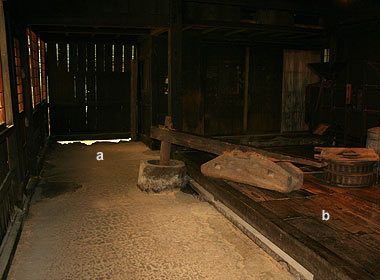|
||
 |
||
2 Pronounced usunawa うすなわ. An area with a low timber floor situated immediately to the rear of the stable *umaya 馬屋 at the lower end *shimote 下手 of traditional farmhouses of the Hida 飛騨 district, Gifu prefecture. Principally an agricultural working space, it sometimes had a hearth *irori 囲炉裏 set into the floor and might also function as a domestic cooking area. In the earliest surviving houses in this district, this area was the doma or *doza 土座. It was referred to as *itaniwa 板庭 when it had a floor.
3 The doma area in the kitchen building, where the cooking range *kamado 竃 was situated. Found in double-ridged farmhouses with a separate kitchen building nakae 中え in parts of Kagoshima prefecture.

2) a) *daidokoro 台所 b) usuniwa 臼庭
Old Taguchi 田口 house
Hida minzokumura・Hida no sato
飛騨民俗村・飛騨の里 (Gifu)
Old Taguchi 田口 house
Hida minzokumura・Hida no sato
飛騨民俗村・飛騨の里 (Gifu)
(C)2001 Japanese Architecture and Art Net Users System. No reproduction or republication without written permission.
掲載のテキスト・写真・イラストなど、全てのコンテンツの無断複製・転載を禁じます。

